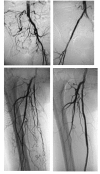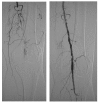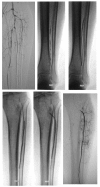Efficacy of endoluminal interventional therapy in diabetic peripheral arterial occlusive disease: a retrospective trial
- PMID: 22373102
- PMCID: PMC3305574
- DOI: 10.1186/1475-2840-11-17
Efficacy of endoluminal interventional therapy in diabetic peripheral arterial occlusive disease: a retrospective trial
Abstract
Background: The purpose of this study was to assess the efficacy of interventional therapy for peripheral arterial occlusive disease and the difference between diabetic patients and non-diabetic patients.
Methods: 139 consecutive patients between September 2006 and September 2010 who underwent percutaneous lower extremity revascularization for arterial lesions were divided into diabetes group (n = 62) and non-diabetes group (n = 77). Before intervention, rest ankle brachial indexes and three dimensional computed tomography angiography from abdominal aorta to tiptoe were performed. The interventional treatments included angioplasty with or without stenting. The clinical outcomes included rest ankle-brachial indexes, primary patency rates, secondary patency rates and limb-salvage rates for 6-month, 12-month, 24-month and 36-month after treatment. The primary and secondary patency rates of all interventions and the limb-salvage rates of the patients are illustrated by Kaplan-Meier curves and compared by log-rank analysis.
Results: The interventional operation success rates were 98.4% (61/62) in diabetes group and 100% (77/77) in non-diabetes group. The re-interventional operation success rates were 85.7% (18/21) in diabetes group and 76.9% (20/26) in non-diabetes group. The mean value of ankle brachial indexes was significantly increased after intervention (0.397 ± 0.125 versus 0.779 ± 0.137, t = -25.780, P < 0.001) in diabetes group and (0.406 ± 0.101 versus 0.786 ± 0.121, t = -37.221, P < 0.001) in non-diabetes group. Perioperative 30-day mortality was 0%. Major complications included groin hematoma in 7.2%, and pseudoaneurysm formation 2.2%. In diabetes group, 6, 12, 24, and 36-month primary patency rates were 88.7% ± 4.0%, 62.3% ± 6.6%, 55.3% ± 7.0%, and 46.5% ± 7.5%; secondary patency rates were 93.5% ± 3.1%, 82.3% ± 5.1%, 70.8% ± 6.5%, and 65.7% ± 7%; limb-salvage rates were 95.2% ± 2.7%, 87.7% ± 4.4%, 85.5% ± 4.8%, and 81.9% ± 5.8%. In non-diabetes group, 6, 12, 24, and 36-month primary patency rates were 90.9% ± 3.3%, 71.8% ± 5.4%, 71.8% ± 5.4%, and 60.9% ± 6.2%; secondary patency rates were 96.1% ± 2.2%, 91.6% ± 3.3%, 82.7% ± 4.8%, and 71.8% ± 6.2%; limb-salvage rates were 97.4% ± 1.8%, 94.4% ± 2.7%, 90.6% ± 3.7%, and 83.1% ± 5.4%. The differences between two groups were not significant (P > 0.05).
Conclusion: With a low risk of morbidity and mortality, the percutaneous revascularization accepted by patients does not affect ultimate necessary surgical revascularization and consequently should be considered as the preferred therapy for chronic lower extremity ischemia. The efficacy and prognosis of interventional therapy in diabetic patients is similar that in non-diabetic patients.
Figures










Similar articles
-
Runoff detected by magnetic resonance angiography as an indicator for better recanalization outcomes in below-the-knee chronic total occlusions in diabetic patients.J Endovasc Ther. 2015 Apr;22(2):243-51. doi: 10.1177/1526602815573229. J Endovasc Ther. 2015. PMID: 25809370
-
Long-term outcomes of patients undergoing endovascular infrainguinal interventions with single-vessel peroneal artery runoff.J Vasc Surg. 2011 Apr;53(4):1007-13. doi: 10.1016/j.jvs.2010.10.057. Epub 2011 Jan 7. J Vasc Surg. 2011. PMID: 21215565
-
Comparison of hybrid procedure and open surgical revascularization for multilevel infrainguinal arterial occlusive disease.Clin Interv Aging. 2014 Sep 22;9:1595-603. doi: 10.2147/CIA.S66860. eCollection 2014. Clin Interv Aging. 2014. PMID: 25284992 Free PMC article.
-
Endovascular therapy: is it effective in the diabetic limb?Semin Vasc Surg. 2012 Jun;25(2):93-101. doi: 10.1053/j.semvascsurg.2012.04.006. Semin Vasc Surg. 2012. PMID: 22817859 Review.
-
Does diabetes mellitus play a role in restenosis and patency rates following lower extremity peripheral arterial revascularization? A critical overview.Ann Vasc Surg. 2008 May-Jun;22(3):481-91. doi: 10.1016/j.avsg.2007.12.012. Epub 2008 Apr 14. Ann Vasc Surg. 2008. PMID: 18411027 Review.
Cited by
-
Influence of fibrinogen and C-RP on progression of peripheral arterial disease in type 2 diabetes: a preliminary report.Cardiovasc Diabetol. 2013 Feb 1;12:29. doi: 10.1186/1475-2840-12-29. Cardiovasc Diabetol. 2013. PMID: 23375154 Free PMC article.
-
The Influence of Diabetes Mellitus on the Outcome of Superficial Femoral Artery Recanalization is Debatable.Transl Med UniSa. 2020 Feb 20;21:10-18. eCollection 2020 Jan-Apr. Transl Med UniSa. 2020. PMID: 32123674 Free PMC article.
-
Comparative vascular responses three months after paclitaxel and everolimus-eluting stent implantation in streptozotocin-induced diabetic porcine coronary arteries.Cardiovasc Diabetol. 2012 Jun 21;11:75. doi: 10.1186/1475-2840-11-75. Cardiovasc Diabetol. 2012. PMID: 22716997 Free PMC article.
-
Using T1 mapping indices to evaluate muscle function and predict conservative treatment outcomes in diabetic patients with peripheral arterial disease.Eur Radiol. 2023 Jul;33(7):4927-4937. doi: 10.1007/s00330-023-09392-8. Epub 2023 Jan 18. Eur Radiol. 2023. PMID: 36651955
-
Real-World Efficacy of Minimally Invasive Revascularization in Diabetic Foot Ischemia: Impact of Device Selection and Lesion-Specific Factors.Biomedicines. 2025 Jun 5;13(6):1384. doi: 10.3390/biomedicines13061384. Biomedicines. 2025. PMID: 40564104 Free PMC article.
References
-
- Eschwege E, Simon D, Balkau B. The growing burden of diabetes in the world population. International Diabetes Federation Bulletin. 1997;42:14–19.
-
- Micari A, Vadalà G, Biamino G. Update on the TURBO BOOSTER spectranetics laser for lower extremity occlusive disease. J Cardiovasc Surg (Torino) 2010;51:233–243. - PubMed
Publication types
MeSH terms
LinkOut - more resources
Full Text Sources
Medical

